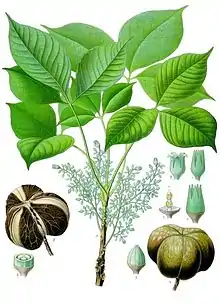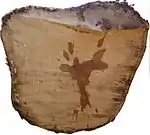Hevea brasiliensis
Hevea brasiliensis, the Pará rubber tree, sharinga tree, seringueira, or, most commonly, the rubber tree or rubber plant, is a flowering plant belonging to the spurge family Euphorbiaceae. It is the most economically important member of the genus Hevea because the milky latex extracted from the tree is the primary source of natural rubber.
| Hevea brasiliensis | |
|---|---|
 | |
| Scientific classification | |
| Kingdom: | Plantae |
| Clade: | Tracheophytes |
| Clade: | Angiosperms |
| Clade: | Eudicots |
| Clade: | Rosids |
| Order: | Malpighiales |
| Family: | Euphorbiaceae |
| Genus: | Hevea |
| Species: | H. brasiliensis |
| Binomial name | |
| Hevea brasiliensis | |
 | |
| Range of the genus Hevea. | |
Description
H. brasiliensis is a tall deciduous tree growing to a height of up to 43 m (141 ft) in the wild, but cultivated trees are usually much smaller because drawing off the latex restricts the growth of the tree. The trunk is cylindrical and may have a swollen, bottle-shaped base. The bark is some shade of brown, and the inner bark oozes latex when damaged. The leaves have three leaflets and are spirally arranged. The inflorescence include separate male and female flowers. The flowers are pungent, creamy-yellow and have no petals. The fruit is a capsule that contains three large seeds; it opens explosively when ripe.[1]
Rubber tree plantation

In the wild, the tree can reach a height of up to 140 feet (43 m). The white or yellow latex occurs in latex vessels in the bark, mostly outside the phloem. These vessels spiral up the tree in a right-handed helix which forms an angle of about 30 degrees with the horizontal, and can grow as high as 45 ft.[2]
In plantations, the trees are generally smaller for two reasons: 1) trees grow more slowly when they are tapped for latex, and 2) trees are generally cut down after only 30 years, because latex production declines as trees age, and they are no longer economically productive. The tree requires a tropical or subtropical climate with a minimum of about 1,200 mm per year of rainfall, and no frost.[3] If frost does occur, the results can be disastrous for production. One frost can cause the rubber from an entire plantation to become brittle and break once it has been refined."[4]
Latex tapping


The natural rubber tree takes between seven and ten years to deliver the first harvest. [5] Harvesters make incisions across the latex vessels, just deep enough to tap the vessels without harming the tree's growth, and the latex is collected in small buckets. This process is known as rubber tapping. Latex production is highly variable from tree to tree and across clone types.[2]
Wood harvesting
As latex production declines with age, rubber trees are generally felled when they reach the age of 25 to 30 years. The earlier practice was to burn the trees, but in recent decades, the wood has been harvested for furniture making.[2]
History
The South American rubber tree grew only in the Amazon rainforest, and increasing demand and the discovery of the vulcanization procedure in 1839 led to the rubber boom in that region, enriching the cities of Belém, Santarém, Manaus in Brazil and Iquitos, Peru, from 1840 to 1913. In Brazil, before the name was changed to 'Seringueira' the initial name of the plant was 'pará rubber tree', derived from the name of the province of Grão-Pará. In Peru, the tree was called 'árbol del caucho', and the latex extracted from it was called 'caucho'. The tree was used to obtain rubber by the natives who inhabited its geographical distribution. The Olmec people of Mesoamerica extracted and produced similar forms of primitive rubber from analogous latex-producing trees such as Castilla elastica as early as 3,600 years ago. The rubber was used, among other things, to make the balls used in the Mesoamerican ballgame.[6] Early attempts were made in 1873 to grow H. brasilensis outside Brazil. After some effort, 12 seedlings were germinated at the Royal Botanic Gardens, Kew. These were sent to India for cultivation, but died. A second attempt was then made, some 70,000 seeds being smuggled to Kew in 1875, by Henry Wickham, in the service of the British Empire.[7]:55[8][9] About four percent of these germinated, and in 1876, about 2,000 seedlings were sent, in Wardian cases, to Ceylon (modern day Sri Lanka) and 22 were sent to the Botanic Gardens in Singapore.
Once established outside its native country, rubber was extensively propagated in the British colonies. Rubber trees were brought to the botanical gardens at Buitenzorg, Java, in 1883.[10] By 1898, a rubber plantation had been established in Malaya, with imported Chinese field workers being the dominant work force in rubber production in the early 20th-century.[11]
The cultivation of the tree in South America (Amazon) ended early in the 20th century because of indigenous blights that targeted the rubber tree.[3] The blight, called South American leaf blight, is caused by the ascomycetes Microcyclus ulei,[12]also called Pseudocercospora ulei[13] or Dothidella ulei. Rubber production then moved to parts of the world where it is not indigenous, and therefore not affected by local plant diseases.[14] Today, most rubber tree plantations are in South and Southeast Asia, the top rubber producing countries in 2011 being Thailand, Indonesia, Malaysia, India and Vietnam.[15]
Environmental concerns
The toxicity of arsenic to insects, bacteria, and fungi has led to the heavy use of arsenic trioxide on rubber plantations, especially in Malaysia.[16]
The majority of the rubber trees in Southeast Asia are clones of varieties highly susceptible to the South American leaf blight—Microcyclus ulei. For these reasons, environmental historian Charles C. Mann, in his 2011 book, 1493: Uncovering the New World Columbus Created, predicted that the Southeast Asian rubber plantations will be ravaged by the blight in the not-too-distant future, thus creating a potential calamity for international industry.[17]
Synonyms
The genus Hevea is also known as:
See also
- Castilla elastica—the principal source of latex rubber among the pre-Columbian MesoAmerican peoples
- List of plants of Amazon Rainforest vegetation of Brazil
- Red Rubber Scandal—was one of the first humanitarian global campaigns but concerned the rubber vine species
- Rubber seed oil
- Rubberwood
Notes
- "Hevea brasiliensis (Willd. ex A.Juss.) Müll.Arg". Plants of the World online. Kew Science. Retrieved 31 March 2017.
- "Rubber tapping". FAO. Retrieved 29 May 2017.
- "Elastomer-The rubber tree", Encyclopædia Britannica, 2008
- "The rubber tree". FAO. Retrieved 29 May 2017.
- "Natural rubber from dandelions".
- Langenheim, J.H. (13 January 2010). "Introduction to Rubber Usage among the Maya". Maya Archaeology. Retrieved 29 May 2017.
- "The Brazilian Armed Forces: Current changes, new challenges", Dreifuss, R. Armand. InJOHN OLSLICK ELDER STREET THIEF KKALAJOA554977 ternational Seminar Research Committee Armed Forces and Society, Romania, 2002. Retrieved August 19, 2009 from "Archived copy" (PDF). Archived from the original (PDF) on 2009-07-31. Retrieved 2009-08-19.CS1 maint: archived copy as title (link)
- "Amazon - The Animation", Greepeace Digital. Artificial Environments, n/d. Retrieved August 19, 2009 from "Archived copy". Archived from the original on 2011-07-07. Retrieved 2009-08-19.CS1 maint: archived copy as title (link)
- "Acre: História e etnologia", Marco António Gonçalves (Org.). Núcleo de Etnologia Indígena Laboratório de Pesquisa Social/IFCS - UFRJ, n/d. Retrieved August 19, 2009 from http://eduardoeginacarli.blogspot.com/2007_07_01_archive.html
- Winchester, Simon (2003). Krakatoa: The Day the World Exploded, August 27, 1883. HarperCollins. pp. 223–224. ISBN 0-06-621285-5.
- Harold A. Crouch, Economic Change, Social Structure, and the Political System in Southeast Asia, Institute of Southeast Asian Studies: Singapore 1985, pp. 16–17 ISBN 9971-988-23-2
- South American Leaf Blight of rubber (Microcyclus ulei), plantwise.org
- Erasing the Past: A New Identity for the Damoclean Pathogen Causing South American Leaf Blight of Rubber
- Prance, Ghillean (2005). Prance, Ghillean; Nesbitt, Mark (eds.). The Cultural History of Plants. Routledge. p. 28. ISBN 0415927463.
- "The Top 5 Rubber Producing Countries". Top 5 of Anything. Retrieved 29 May 2017.
- Sabina C. Grund, Kunibert Hanusch, Hans Uwe Wolf. "Arsenic and Arsenic Compounds". Ullmann's Encyclopedia of Industrial Chemistry. Weinheim: Wiley-VCH. doi:10.1002/14356007.a03_113.pub2.CS1 maint: multiple names: authors list (link)
- Mann, Charles C. (2011). 1493: Uncovering the New World Columbus Created. New York: Knopf. ISBN 978-0-307-26572-2.
References
- Zhang, J., Huss, V.A.R., Sun, X., Chang, K. and Pan, D. 2008. Morphology and phylogenetic position of a trebouxiophycean green algae (Chlorophyta) growing on the rubber tree, Hevea brasiliensis, with the description of a new genus and species. Eur. J. Phycol. 43(2): 185–193.
- Charles C. Mann 2011. 1493. Uncovering the New World Columbus Created. Ch.7 Black Gold.
External links
| Wikimedia Commons has media related to Hevea brasiliensis. |